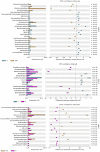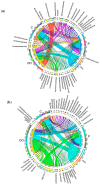Implications of Soil Pollution with Diesel Oil and BP Petroleum with ACTIVE Technology for Soil Health
- PMID: 31336741
- PMCID: PMC6678237
- DOI: 10.3390/ijerph16142474
Implications of Soil Pollution with Diesel Oil and BP Petroleum with ACTIVE Technology for Soil Health
Abstract
Grass Elymus elongatus has a potential in phytoremediation and was used in this study in a potted experiment, which was performed to determine the effect of polluting soil (Eutric Cambisol) with diesel oil (DO) and unleaded petroleum (P) on the diversity of soil microorganisms, activity of soil enzymes, physicochemical properties of soil, and on the resistance of Elymus elongatus to DO and P, which altogether allowed evaluating soil health. Both petroleum products were administered in doses of 0 and 7 cm3 kg-1 soil d.m. Vegetation of Elymus elongatus spanned for 105 days. Grasses were harvested three times, i.e., on day 45, 75, and 105 of the experiment. The study results demonstrated a stronger toxic effect of DO than of P on the growth and development of Elymus elongatus. Diesel oil caused greater changes in soil microbiome compared to unleaded petroleum. This hypothesis was additionally confirmed by Shannon and Simpson indices computed based on operational taxonomic unit (OTU) abundance, whose values were the lowest in the DO-polluted soil. Soil pollution with DO reduced the counts of all bacterial taxa and stimulated the activity of soil enzymes, whereas soil pollution with P diminished the diversity of bacteria only at the phylum, class, order, and family levels, but significantly suppressed the enzymatic activity. More polycyclic aromatic hydrocarbons (PAHs) were degraded in the soil polluted with P compared to DO, which may be attributed to the stimulating effect of Elymus elongatus on this process, as it grew better in the soil polluted with P than in that polluted with DO.
Keywords: PAHs degradation; bacteria metagenomics; enzymatic activity; grass resistance.
Conflict of interest statement
The authors declare no conflict of interest. The funders had no role in the design of the study; in the collection, analyses, or interpretation of data; in the writing of the manuscript, or in the decision to publish the results.
Figures









Similar articles
-
Microbiological Study in Petrol-Spiked Soil.Molecules. 2021 May 1;26(9):2664. doi: 10.3390/molecules26092664. Molecules. 2021. PMID: 34062889 Free PMC article.
-
Role of Festuca rubra and Festuca arundinacea in determinig the functional and genetic diversity of microorganisms and of the enzymatic activity in the soil polluted with diesel oil.Environ Sci Pollut Res Int. 2019 Sep;26(27):27738-27751. doi: 10.1007/s11356-019-05888-3. Epub 2019 Jul 23. Environ Sci Pollut Res Int. 2019. PMID: 31338761 Free PMC article.
-
The Role of Dactylis Glomerata and Diesel Oil in the Formation of Microbiome and Soil Enzyme Activity.Sensors (Basel). 2020 Jun 13;20(12):3362. doi: 10.3390/s20123362. Sensors (Basel). 2020. PMID: 32545819 Free PMC article.
-
Advances in research on petroleum biodegradability in soil.Environ Sci Process Impacts. 2021 Feb 4;23(1):9-27. doi: 10.1039/d0em00370k. Environ Sci Process Impacts. 2021. PMID: 33393551 Review.
-
Biodegradation of polycyclic aromatic hydrocarbons: Using microbial bioelectrochemical systems to overcome an impasse.Environ Pollut. 2017 Dec;231(Pt 1):509-523. doi: 10.1016/j.envpol.2017.08.048. Epub 2017 Aug 29. Environ Pollut. 2017. PMID: 28841503 Review.
Cited by
-
Microbiological Study in Petrol-Spiked Soil.Molecules. 2021 May 1;26(9):2664. doi: 10.3390/molecules26092664. Molecules. 2021. PMID: 34062889 Free PMC article.
-
Mineral and Organic Materials as Factors Reducing the Effect of Petrol on Heavy Metal Content in Soil.Materials (Basel). 2024 Jul 16;17(14):3528. doi: 10.3390/ma17143528. Materials (Basel). 2024. PMID: 39063820 Free PMC article.
-
The Role of Grass Compost and Zea Mays in Alleviating Toxic Effects of Tetracycline on the Soil Bacteria Community.Int J Environ Res Public Health. 2022 Jun 15;19(12):7357. doi: 10.3390/ijerph19127357. Int J Environ Res Public Health. 2022. PMID: 35742602 Free PMC article.
-
Remarkable shift in structural and functional properties of an animal charcoal-polluted soil accentuated by inorganic nutrient amendment.J Genet Eng Biotechnol. 2020 Nov 11;18(1):70. doi: 10.1186/s43141-020-00089-9. J Genet Eng Biotechnol. 2020. PMID: 33175233 Free PMC article.
-
Applicability of Compost and Mineral Materials for Reducing the Effect of Diesel Oil on Trace Element Content in Soil.Materials (Basel). 2023 May 11;16(10):3655. doi: 10.3390/ma16103655. Materials (Basel). 2023. PMID: 37241282 Free PMC article.
References
-
- International Energy Agency (IEA) Oil Market Report. International Energy Agency; Paris, France: 2019. p. 55.
-
- Hawrot-Paw M., Nowak A. An attempt at mathematical modelling of the process of microbiological biodegradation of diesel oil. Environ. Prot. Eng. 2012;38:23–29.
-
- Waheed S.M., Sangal P., Shukla S. Microbiological analysis for hydrocarbon exploration. Environ. Risk Assess. Remediat. 2018;2:1–7. doi: 10.4066/2529-8046.100042. - DOI
Publication types
MeSH terms
Substances
LinkOut - more resources
Full Text Sources

